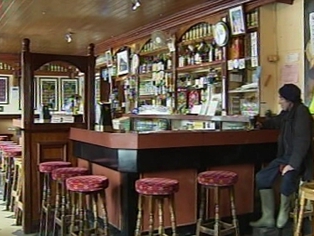Irish Banks refuse 57% of SME loan applications – says ISME
Mark Fielding of ISME.
ON AVERAGE IT TOOK BANKS FIVE WEEKS TO GIVE A DECISION ON A CREDIT APPLICATION, ACCORDING TO THE ISME SURVEY
Nearly six out of ten loan applications made by small businesses in the last three months were turned down by the main banks, according to a survey by the Irish Small and Medium Enterprises Association.
ISME’s Quarterly Bank Watch Survey shows that 57% of funding applications made in the past quarter were refused, up from a refusal rate of 44% seen in the last quarter.
The survey also found that, on average, the length of time it took for a decision to be given by a bank had increased from four weeks to five.
However 14% of initial bank decisions were made within one week – a 1% improvement on the previous quarter.
More than 1,020 owner-managers of SMEs responded to the survey, which represents 14.7% of those asked.
Of those respondents, 35% had requested credit in the past quarter, down from 41% in the last survey.
ISME said that 12% of those who required finance did not apply for a number of reasons, with one third of those claiming they were discouraged by their bank from making such applications.
Moynalty, Co Meath named Ireland’s overall tidiest town for 2013
Judges impressed by Moynalty level of care as village awarded top prize, narrowly pipping Killarney, Ennis and Kenmare to the honour – and €10,000 cheque
The village was unveiled as the overall winner of the annual Supervalu National Tidy Towns competition at a ceremony in Dublin today.
It is the first overall victory for Moynalty, and the first Meath winner of the competition since Trim took the top prize in 1984.
The judges commended organisers for topping the list of 832 towns and villages which entered this year’s competition,
As Ireland’s tidiest village with 316 points, it receives a trophy and a cheque for €5,000. A second trophy and cheque for €10,000 is also awarded as overall winner.
“This is a fantastic achievement for Moynalty after 53 years in the competition; a really worthy winner,” Environment Minister Phil Hogan said.
“My congratulations to Moynalty and all of the other prize-winners today. I am always impressed by the ambition and enthusiasm of all those involved in the TidyTowns effort. These people volunteer their time, effort and expertise, year on year, to help make their communities better places to live and work in.
“The results of their efforts are obvious in the attractive, well cared-for towns and villages we see throughout the country. It is clear that working together, getting to know your neighbours, and getting things done increases peoples’ pride in where they live and helps to build vibrant communities.”
Moynalty took the Silver Medal Award at the international LivCom 2012 in Abu Dhabi, and judges said it was “no surprise” that the village was one of the most liveable communities in the world.
All buildings looked “recently painted and without exception look well”, the judges said. Some 2,000 trees planted and construction of new stone flower beds were an “attractive development”, while picking up litter twice a day was “unquestionably the most important tool for maintaining the village litter-free”.
Moynalty also claimed the award of Ireland’s Tidiest Village. Other winnersincluded Kenmare, Co Kerry which received the award for Ireland’s Tidiest Small Town, Killarney, Co Kerry received the award of Ireland’s Tidiest Large Town, and Ennis, Co. Clare retained their title as Ireland’s Tidiest Large Urban Centre.
Managing director of SuperValu, Martin Kelleher, said the Tidy Towns committees made a “real difference” at local level.
“SuperValu TidyTowns is the public expression of the work countless individuals undertake to build community spirit and make their local area a better place to live,” he said.
“SuperValu together with its countrywide network of local retailers is – through the continued sponsorship of TidyTowns – committed to helping build and support vibrant local communities. I am delighted to congratulate this year’s winners and to recognise the commitment and dedication of TidyTowns committees nationwide who make such a real difference at a local level”.
More than 800 towns and villages have entered the competition over the last three years.
One pub a day closes in Ireland according to Drinks Industry Group DIGI.
The Drinks Industry Group of Ireland (DIGI) this week called for a reversal in the tax increases on alcohol that was introduced in last year’s budget, as almost a pub a day closes and sales continue to decline.
The organisation points out at the rate of pub closures had almost doubled since the excise increase in last year’s budget.
Previously three pubs were closing a week, but since the excise increase in last year’s budget almost a pub a day has closed, according to Revenue Commissioner data. In a pre-budget submission to Minister for Finance Michael Noonan, DIGI has warned that last year’s tax increases are threatening jobs and tourism and damaging the Government’s tax take.
Peter O’Brien, Chair of the Drinks Industry Group of Ireland and Diageo’s European Corporate Relations Director said: “The reality is that taxes kill jobs, the excise increase killed jobs. The rate of pubs closing has doubled since the measure was introduced and we are now looking at the grim reality where almost a pub a day is closing.
 Last year’s excise increase is not meeting desired targets. Budget 2013 expected excise to increase by €180 million or 21% on the 2012 level without allowing for buoyancy effects. The Government should be setting up a task force to assist these small family-run businesses, and reverse last year’s excise increase.
Last year’s excise increase is not meeting desired targets. Budget 2013 expected excise to increase by €180 million or 21% on the 2012 level without allowing for buoyancy effects. The Government should be setting up a task force to assist these small family-run businesses, and reverse last year’s excise increase.
Figures for the first five months of 2013 show that alcohol excise receipts are substantially below the expected increase. Anthony Foley, DCU Business School said: “The overall drinks market continued to decline in the first half of 2013 compared with 2012. Bar sales volume continued to decline with a slower decline in the second quarter than in the first quarter.
Sales value dropped by less than the volume decrease due to the excise and supplier induced price increases. Off-licence sales declined in the first half of 2013. According to clearance figures, cider sales have dropped by almost 8 per cent in the period, wine by 9 per cent and spirits by 13.5 per cent, beer is up slightly. The domestic drinks market has weakened further in 2013.”
Last year’s budget saw a 10 cent increase on beer and spirits and €1 added to the price of a bottle of wine. Wine excise is now the highest in Europe, tax on cider is second highest in EU, tax on spirits is the third highest and taxes on beer are the fourth highest. According to Eurostat, the price of alcohol in Ireland is 62% higher than the EU average.
Faulty prostate cancer testing kits withdrawn at Connolly Dublin and Mayo hospitals
Key prostate indicators up to 23 per cent too high because of equipment failure
Mayo General Hospital is reviewing the results of almost 13,000 tests for prostate cancer after it emerged the model of kits used on patients was faulty and resulting in artificially high readings.
News that such a high number of tests are being reviewed comes after Connolly Hospital in Blanchardstown, Dublin, said it had withdrawn the kits after they were found to be faulty.
The kits, manufactured by Siemens, are used to measure PSA, a protein made by the prostate gland and which, when raised, may indicate the presence of prostate cancer.
They were used at Blanchardstown hospital between February 2013 and June 2013 and in Mayo General between July 2012 and June 2013. They indicated levels of protein up to 23 per cent higher than reliable working kits.
A total of 12,866 tests were carried out in Mayo General in the period and in a statement the hospital said its review would determine how many results were elevated as a result of the faulty equipment.
“This incident, which is outside the control of Mayo General Hospital, is considered to be of low clinical risk in relation to long-term negative outcomes for patients,” the statement said.
In Blanchardstown, some 2,186 patients were tested during the period and of these, 162 received a result which may have indicated a need for further investigation.
In a statement, the HSE said it was reviewing the results of these 162 patients in Blanchardstown to determine if further actions were necessary.
It said it was in contact with GPs to track patient outcomes. Similar steps were being taken in Mayo with a view to offering doctors re-tests for any patients.
PSA tests at Connolly Hospital are currently being sent toBeaumont Hospital for analysis where the Siemens kits are not in use. A spokesman for the HSE was unable to say when analysis of PSA tests would resume at Connolly Hospital.
Mayo General Hospital said an alternative method of testing had been in place since July when the issue with the Siemens kit emerged.
A statement from the hospital added that since late June, a notice for doctors had been attached to all PSA test results from the new method, informing them a new test was being used and alerting them to the elevated levels in the now discontinued Siemens testing kit.
UK scientists to probe ANTARCTICA’S Pine Island Glacier


UK SCIENTISTS ARE ABOUT TO SET OUT FOR ANTARCTICA TO INVESTIGATE THE MIGHTY PINE ISLAND GLACIER.
The PIG drains about 10% of all the ice sliding off the west of the continent, and has seen a marked thinning and a surge in velocity in recent decades.
Its contribution to sea level rise is now greater than any other glacier on the planet.
The British Antarctic Survey-led team hopes its iStar project will provide new insights into the PIG’s behaviour.
The researchers will gather their measurements using a diverse set of techniques and technologies, including robotic subs and satellites, and even instrument-carrying elephant seals.
“We want to improve our understanding of what this glacier is doing and to use that informationto be able to make good predictions for its contribution to global sea level in the years ahead,” said Dr Andy Smith, iStar’s science programme manager at BAS.
“And if we can do that, if we can make those good predictions, then we’ll also have some tools to apply to the rest of the Antarctic and the Greenland ice sheet as well,” he told BBC News.
Dr Smith officially announced the venture on Monday at the British Science Association annual festival in Newcastle.
A traverse across the glacier by tractor will acquire a raft of new measurements
The PIG is vast. The glacier runs alongside the Hudson mountains into the Amundsen Sea, draining an area covering more than 160,000 sq km – about two-thirds the size of the UK. And it can produce colossal icebergs, such as the 720-sq-km “ice island” that broke off into the ocean in July.
But the PIG’s remoteness has made it difficult to study, and it is only in the past 20 years or so, with the aid of satellites, that scientists have realised the glacier is undergoing significant change.
Space data indicates the rate at which it is losing mass is doubling about every five years.
This acceleration has been attributed in part to warmer ocean waters getting under and melting the PIG’s ice shelf – the long floating tongue that protrudes out into Amundsen Bay. The grounding line – the point where this shelf starts to become buoyant – has pulled back further and further towards the land.
The iStar project has two major expeditions this Antarctic summer to try to probe more keenly how the warming of the ocean is coupling to the drawdown of ice deep inland.
Small oceanographic sensors attached to the seals’ fur fall off after a few months
The first mission, starting in November, is a 10-week, 1,000km traverse by tractor across the top of the glacier. One of its tasks will be to map the rockbed beneath Pine Island Glacier. Much of the traverse data is expected to feed back into the validation of future space monitoring, says Dr Andy Shepherd of Leeds University.
“We need field measurements to beat down the remaining uncertainties in the satellite data,” he told the BBC.
“There will be ground measurements that help us understand how much rock uplift there is beneath the ice; how much compaction of snow there is at the surface of the glacier; and indeed how much variability there is in the snowfall from year to year.
“All of these factors can complicate the signal and we want to iron them out so that scientists can see that the satellite numbers are robust and can be trusted.”
The nearly three-tonne Autosub operates on its own for up to 30 hours
In January, iStar’s oceanographers are expected to arrive in the Amundsen Sea onboard the RRS James Clark Ross.
They will be putting a fleet of ocean robots known as Seagliders into the water. These vehicles measure temperature, salinity and current behaviour at different depths. The gliders will operate in front of the ice shelf. The ship will, however, release its big unmanned submarine, Autosub, to go under the shelf.
This 7m-long probe will map the cavity and the geometry of a ridge on the seabed that appears to play a key role in limiting the ingress of warm water from the ocean.
BAS has new technologies, such as air-dropped GPS stations, to monitor glacier flow
“We want to look in more detail at the processes that control the exchange of waters over this ridge, and in particular the mixing of the waters as they go in and out,” said Dr Adrian Jenkins from BAS.
“What the structure of the water column looks like – the warm layer below, the cold layer on top and a transition layer between the two – in relation to the height of this ridge, and the exchange that’s possible over the ridge, is absolutely critical to what happens in the future.”
The ship will only have 30 days in Amundsen Bay to complete its work, but the scientists plan to leave autonomous instruments behind to gather ocean and ice information throughout the winter. It is in winter, also, when the elephant seals will do their work.
Researchers from St Andrews University have developed small sensors that can be glued to the animals’ coats. These gather data, such as water temperature and saltiness, as the seals swim.
The measurements are fed back to the UK via satellite whenever the seals surface. Eventually, after several months, the mammals moult and the sensors fall off.
The £7.4m iStar programme has been funded by the National Environment Research Council and is expected to take six years to complete.








No comments:
Post a Comment